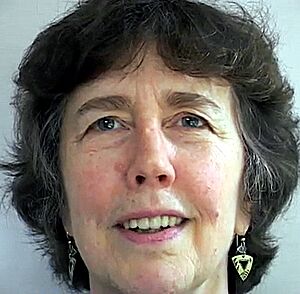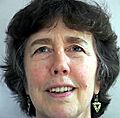Joan Tower facts for kids
Quick facts for kids
Joan Tower
|
|
|---|---|

Tower (circa 2003)
|
|
| Born | September 6, 1938 New Rochelle, New York, U.S.
|
Joan Tower (born September 6, 1938) is a famous American composer, pianist, and conductor. She has won several Grammy Awards for her music. Many people, including The New Yorker magazine, say she is one of the most successful women composers ever.
Her music is often described as strong and full of energy. It has been played in concert halls all around the world. She became well-known for her first orchestral piece, Sequoia (1981). This piece is like a musical story that describes a giant tree, from its trunk to its tiny needles.
After Sequoia, she wrote many other instrumental works. These include Fanfare for the Uncommon Woman, which is a nod to Aaron Copland's Fanfare for the Common Man. She also composed Island Prelude, five string quartets, and other musical stories. Tower was also a pianist and a founder of the Naumburg Award-winning Da Capo Chamber Players. This group asked her to write many of her early works, like her popular piece Petroushskates.
Contents
Life and Career of a Composer
Early Life and Musical Beginnings
Joan Tower was born in New Rochelle, New York, in 1938. When she was nine, her family moved to Bolivia. She says living there helped her love rhythm, which became a big part of her music. She found this love for rhythm at local celebrations, where she learned to play percussion instruments.
Her father was a mineralogist, someone who studies minerals. He made sure she had lots of music lessons, and her piano skills grew quickly. Her father's work with minerals even inspired some of her music. She wrote pieces like Black Topaz (1976) and Silver Ladders (1986).
As a young woman, she returned to the United States to study music. She went to Bennington College and then Columbia University. At Columbia, she earned her doctorate in composition in 1968.
Forming the Da Capo Chamber Players
In 1969, Joan Tower helped start the Da Capo Chamber Players in New York. She played the piano for the group. In the late 1970s and early 1980s, she wrote many successful pieces for them. These included Platinum Spirals (1976), Amazon I (1977), and Wings (1981). The group won several awards, like the Walter W. Naumburg International Competition Award in 1973.
Tower left the group in 1984 because her first orchestral piece, Sequoia (1981), was very successful. She was also inspired by jazz music. She saw famous jazz musicians like Miles Davis and John Coltrane in New York City clubs. This led her to play jazz piano for ten years and use jazz sounds in her own compositions.
Teaching and Major Awards
In 1972, Tower began teaching composition at Bard College. She still teaches there today. She received a Guggenheim Fellowship in 1976, which is a special award for artists and scholars. From 1985 to 1988, she was the composer-in-residence for the St. Louis Symphony Orchestra. This meant she worked closely with the orchestra, often writing new music for them.
In 1990, Joan Tower became the first woman to win the Grawemeyer Award for Music. This was for her composition Silver Ladders. In 1993, the Milwaukee Ballet asked her to compose Stepping Stones. She even conducted parts of it at the White House. Other works from the 1990s include the third Fanfare for the Uncommon Woman and piano concertos. One notable piano concerto was Rapids (Piano Concerto no. 2) from 1996. She also wrote Tambor (1998) for the Pittsburgh Symphony Orchestra.
In 1999, Tower became the composer-in-residence for the Orchestra of St. Luke's. In 1998, she won the Delaware Symphony's Alfred I. DuPont Award. This award recognizes distinguished American composers.
Recent Achievements and Recognition
In 2002, Tower won the Annual Composer's Award from the Lancaster Symphony Orchestra. In 2004, the Nashville Symphony's recording of her works, including Tambor, Made in America, and her Concerto for Orchestra, was nominated for a Grammy Award.
Also in 2004, Carnegie Hall in New York City featured a special series about Tower's music. In 2005, she became the first composer chosen for the "Ford Made in America" program. This unique program allowed smaller orchestras across the United States to commission new music. Her 15-minute piece Made in America was performed in every state between 2005 and 2007.
In 2008, Tower's Made in America recording by the Nashville Symphony won three Grammy Awards. These awards were for Best Orchestral Performance, Best Classical Album, and Best Classical Contemporary Composition.
Her music has been performed by many top orchestras and groups worldwide. These include the New York Philharmonic and the Boston Symphony Orchestra. She is currently a professor of music at Bard College. She is also a member of the American Academy of Arts and Letters.
Joan Tower's Musical Style
From Early Influences to Unique Sound
Joan Tower's early music was influenced by her teachers at Columbia University. It followed a style called serialism, which often has a simple sound. As she grew as a composer, she started to be inspired by composers like Olivier Messiaen and George Crumb. She moved away from the strict serialist style.
Her music became more colorful and is often described as impressionistic. This means it creates a mood or feeling rather than a clear picture. She often writes music with specific groups or solo musicians in mind. She tries to highlight their strengths in her compositions.
The Uncommon Woman Fanfares
Among her most famous works is the six-part Fanfare for the Uncommon Woman. Each part is dedicated to "women who are adventurous and take risks." These fanfares were inspired by Aaron Copland's Fanfare for the Common Man.
Four of the six parts are written for trumpets, horns, trombones, tuba, and percussion. The first part was played for the first time in 1987. The fifth part was written especially for Joan W. Harris. The first five parts were added to the National Recording Registry in 2014. This means they are considered important recordings in American history.
Selected Works
Ballet
- Stepping Stones (1993), commissioned by the Milwaukee Ballet. The dance was created by Kathryn Posin.
Orchestral Works
- Sequoia (1981)
- Music for Cello and Orchestra (1984)
- Island Rhythms (1985)
- Concerto for Piano (Homage to Beethoven) (1985)
- Silver Ladders (1986)
- Clarinet Concerto (1988)
- Flute Concerto (1989)
- Island Prelude (1989), for oboe and string orchestra
- Concerto for Orchestra (1991)
- Fanfare for the Uncommon Woman (1987–1992)
- Violin Concerto (1992)
- Duets (1994), for chamber orchestra
- Paganini Trills (1996)
- Rapids (Piano Concerto No. 2) (1996)
- Tambor (1998)
- The Last Dance (2000)
- Fascinating Ribbons (2001), for concert band
- Strike Zones (2001), a concerto for percussion and orchestra
- In Memory (2002), for string orchestra
- Made in America (2004), for chamber orchestra
- Purple Rhapsody (2005), concerto for viola and chamber orchestra
- Chamber Dance (2006), for chamber orchestra
- Stroke (2010)
- Red Maple (2013), for bassoon and string orchestra
- 1920/2019 (2020) for orchestra
- A New Day (2021) for cello and orchestra
Chamber Music
- Breakfast Rhythms I. and II. (1974)
- Black Topaz (1976)
- Amazon I. (1977)
- Petroushskates (1980)
- Noon Dance (1982)
- Fantasy... Harbour Lights (1983)
- Snow Dreams (1983)
- Fanfare for the Uncommon Woman (1986)
- Island Prelude (1989)
- Second Fanfare for the Uncommon Woman (1989)
- Third Fanfare for the Uncommon Woman (1991)
- Celebration Fanfare (1993)
- Elegy (1993)
- Fifth Fanfare for the Uncommon Woman (1993)
- Night Fields (String Quartet No. 1) (1994)
- Très lent (Hommage à Messiaen) (1994)
- Turning Points (1995)
- And...they're off (1997)
- Rain Waves (1997)
- Toccanta (1997)
- Big Sky (2000)
- In Memory (String Quartet No. 2 (2002)
- Incandescent (String Quartet No. 3) (2003)
- For Daniel (2004)
- DNA (2005)
- A Little Gift (2006)
- Copperwave (2006)
- A Gift (2007)
- Trio Cavany (2007)
- Angels (String Quartet No. 4) (2008)
- Dumbarton Quintet (2008)
- Rising (2009)
- White Granite (2010)
- White Water (String Quartet No. 5) (2011)
Vocal Works
- Can I (2007), for choir and percussionist. This was written for the Young People's Chorus of New York City.
Solo Works
- Circles (1964), for piano
- Fantasia (1966), for piano
- Platinum Spirals (1976), for violin
- Red Garnet Waltz (1977), for piano
- Wings (1981), for clarinet or alto saxophone
- Clocks (1985), for guitar
- Or like a...an engine (1994), for piano
- Ascent (1996), for organ
- Holding a Daisy (1996), for piano
- Valentine Trills (1996), for flute
- Wild Purple (1998), for viola
- Vast Antique Cubes/Throbbing Still (2000), for piano
- Simply Purple (2008), for viola
- Ivory and Ebony (2009), for piano
- For Marianne (2010), for flute
- String Force (2010), for violin
- Steps (2011), for piano
- Purple Rush (2016), for viola
Interviews
- Joan Tower interviewed by Michael Schell, July 22, 2021 on Radio Eclectus, KHUH-LP
- At 80, Joan Tower Says Great Music Comes ‘in the Risks’, New York Times, November 9, 2018, by William Robin
- Joan Tower interview by Bruce Duffie, April, 1987
- Joan Tower. Interview with Frank J. Oteri. Joan Tower: Made In America. September 15, 2005.
- The composer in conversation with Bruce Duffie, published in New Music Connoisseur Magazine, Spring, 2001.
Images for kids
See also
 In Spanish: Joan Tower para niños
In Spanish: Joan Tower para niños


